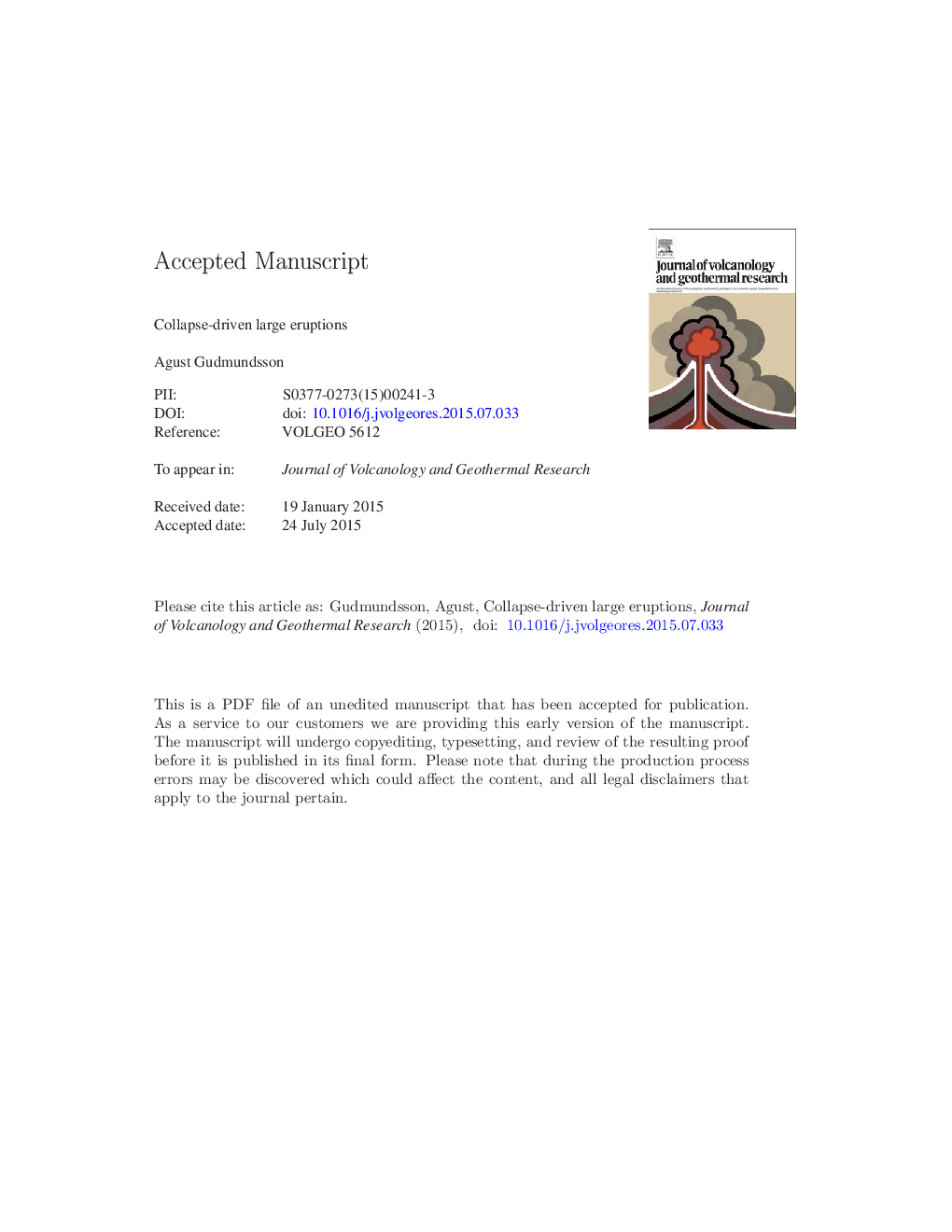| کد مقاله | کد نشریه | سال انتشار | مقاله انگلیسی | نسخه تمام متن |
|---|---|---|---|---|
| 6439778 | 1638318 | 2015 | 49 صفحه PDF | دانلود رایگان |
عنوان انگلیسی مقاله ISI
Collapse-driven large eruptions
ترجمه فارسی عنوان
انفجارهای گسترده ای در حال فروپاشی است
دانلود مقاله + سفارش ترجمه
دانلود مقاله ISI انگلیسی
رایگان برای ایرانیان
کلمات کلیدی
آتشفشان ها، اتاق مگا، سقوط کالدراس، مخاطرات آتشفشانی، حلقه دایک، استرس پوسته،
ترجمه چکیده
برای یک محفظه ماگما پوسته ای کم عمق پوسته پوسته، حدود 0.1٪ از ماگما مافیایی و حدود 4٪ از ماگما فلزی در طی پارگی ماگما فوران می شود و یا تزریق می شود. اتاق های ماگما با حجم ده ها تا چند صد کیلومتر مکعب، به طور معمول، به اندازه کافی بزرگ هستند تا ماگما را به فوران های کوچک یا متوسط بدهد. اما برای فوران های بزرگ، درصد بسیار بیشتری از حجم ماگما باید از محفظه فشرده شود. برای یک اتاق مجاور معمولی، فشار اضافی در محفظه در طول فوران، به صورت نمادین کاهش می یابد. با این وجود، برای فوران بزرگی ممکن است، فشار بیش از حد باید تا پایان انتهای فوران ادامه یابد. در اینجا من نشان می دهم که فروپاشی کلدرا می تواند فشار بیش از حد را از طریق کاهش حجم مجتمع ماگما حفظ کند؛ در این صورت فوران ناشی از بزرگ شدن، نتیجه (و نه علت) سقوط خواهد بود. من همچنین نشان می دهم که غوطه ور شدن حلقه تا حدی اندازه و شدت (جریان حجمی یا میزان افیوژن) فوران را کنترل می کند. اگر خطای حلقه به سمت داخل حرکت کند (یک خطای طبیعی)، جابه جایی "پایدار" است، جریان جریان حجمی (شدت) در طول فروپاشی اساسا ثابت باقی می ماند و محفظه ماگما پس از فروپاشی فعال می شود. در مقابل، اگر خطای حلقه به سمت خارج حرکت کند (گسل معکوس)، جابه جایی "ناپایدار" است، جریان جریان حجمی به طور طبیعی در طول فروپاشی به طور چشمگیری افزایش می یابد و محفظه ماگما در طول فروپاشی کاملا تخریب می شود.
موضوعات مرتبط
مهندسی و علوم پایه
علوم زمین و سیارات
ژئوشیمی و پترولوژی
چکیده انگلیسی
For a typical poroelastic shallow crustal magma chamber, about 0.1% of the mafic magma and about 4% of the felsic magma are erupted and/or injected during magma-chamber rupture. Magma chambers with volumes of the order of several tens to several hundred cubic kilometres, as are common, are thus sufficiently large to supply magma to small or moderate eruptions. For large eruptions, however, a much higher percentage of the magma volume must be squeezed out of the chamber. For an ordinary poroelastic chamber, the excess pressure in the chamber falls exponentially during the eruption. For a large eruption to be possible, however, the excess pressure must be essentially maintained until the very end of the eruption. Here I show that caldera collapse can maintain the excess pressure through forced magma-chamber volume reduction, in which case a resulting large eruption would be the consequence (not the cause) of the collapse. I also show that ring-fault dip partly controls the size and intensity (volumetric flow or effusion rate) of the eruption. If the ring-fault dips inward (a normal fault), the displacement is 'stable', the volumetric flow rate (intensity) remains essentially constant during the collapse, and the magma chamber remains active following the collapse. By contrast, if the ring-fault dips outward (a reverse fault), the displacement is 'unstable', the volumetric flow rate normally increases dramatically during the collapse, and the magma chamber may be entirely destroyed during the collapse.
ناشر
Database: Elsevier - ScienceDirect (ساینس دایرکت)
Journal: Journal of Volcanology and Geothermal Research - Volume 304, 1 October 2015, Pages 1-10
Journal: Journal of Volcanology and Geothermal Research - Volume 304, 1 October 2015, Pages 1-10
نویسندگان
Agust Gudmundsson,
